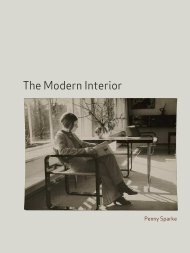Landscape Architecture: Landscape Architecture: - School of ...
Landscape Architecture: Landscape Architecture: - School of ...
Landscape Architecture: Landscape Architecture: - School of ...
- No tags were found...
Create successful ePaper yourself
Turn your PDF publications into a flip-book with our unique Google optimized e-Paper software.
McLean’s Nuggets<br />
Learning from the Locals<br />
The end <strong>of</strong> 2006 saw the publication <strong>of</strong> the Stern Review,<br />
the British government’s long-awaited report on the<br />
economics <strong>of</strong> climate change. Solar panels and wind turbines<br />
go on sale in Europe’s biggest DIY chain. A frenzy <strong>of</strong><br />
excitement/opportunism grows around renewables strategies.<br />
Impending puritanical tax initiatives are mooted, ready to<br />
punish you for that big car or sun-seeking holiday via lowcost<br />
airlines, and the mayor <strong>of</strong> London considers outlawing<br />
the incandescent light bulb. Meanwhile, prominent<br />
environmental campaigner George Monbiot writes what<br />
seems a less than useful article about the nonbenefits <strong>of</strong><br />
small-scale renewable power generation. In an article<br />
entitled ‘Low-wattage thinking’, in New Scientist magazine,<br />
he states: ‘In almost all circumstances, micro wind turbines<br />
are a waste <strong>of</strong> time and money.’ His chief concern appears<br />
to be that such homespun solutions are actually a distraction<br />
rather than a solution to our future energy needs.<br />
Within the context <strong>of</strong> this mix-messaged environmental<br />
age, the usefulness <strong>of</strong> the comprehensive (I struggle to<br />
include the rather ‘new-age’ holistic) thinker/designer seems<br />
increasingly useful. John-Paul Frazer is able to span the<br />
unhelpful distinctions between architect and environmental<br />
designer. In an ongoing research and embryonic construction<br />
project, ’Mrittikalaya’ (Abode <strong>of</strong> Earth), Frazer is proposing<br />
a new kind <strong>of</strong> highly tunable architecture situated in the<br />
extreme climate <strong>of</strong> the Thar Desert in Rajasthan, India. For<br />
six years he has undertaken a study <strong>of</strong> desert organisms,<br />
revealing a diverse range <strong>of</strong> extreme heat adaptation that<br />
can be harnessed in ‘human technological or behavioural<br />
analogues such as seeking shade and shelter underground’.<br />
In a recent lecture at the University <strong>of</strong> Westminster, Frazer<br />
described this process as ‘learning from the locals’. Like<br />
Bernard Rud<strong>of</strong>sky in his seminal book <strong>of</strong> 1964, <strong>Architecture</strong><br />
without Architects, Frazer does not make a distinction<br />
between the evolved disposition <strong>of</strong> an organism and the<br />
evolved disposition <strong>of</strong> the artefacts <strong>of</strong> that organism. We<br />
have evidently as much to learn from local clothing,<br />
vernacular architecture and behaviour (customs) as we do<br />
from local flora and fauna, insect and animal life.<br />
Working with Andy Ensor, Yonca Ersen and Jyrki Romo,<br />
Frazer has recently designed a two-bedroom house for a<br />
research scientist couple in this extreme environment,<br />
utilising some <strong>of</strong> his empirical research. The building is<br />
largely buried underground, using the temperature<br />
stability that a subterranean (below 3 metres/9 2 / 3 feet)<br />
environment can afford you: 27°C (80°F) in this instance,<br />
which is considerably less than summer highs <strong>of</strong> 50°C<br />
(122°F) – (surface air temperature) – and considerably more<br />
than the freezing winter nights. Other design strategies<br />
include additional Shade-Scoop-Sails (or ‘Chiks’), the<br />
‘fissured morphology’ <strong>of</strong> the self-shading Cactus Render, a<br />
Wind-Scoop Tower with evaporative cooling ‘Mist<br />
Chandelier’, and a substantial network <strong>of</strong> Coolth storage<br />
tanks, cooled by a night-time radiative cooling system. This<br />
cooling system comprises a series <strong>of</strong> radiators on the ro<strong>of</strong>,<br />
covered with deployable insulated petals, opened and<br />
closed by novel actuators/pistons made <strong>of</strong> bamboo and<br />
mustard oil mix. Add a Suck-Stack chimney over the central<br />
core <strong>of</strong> the building and the innovation <strong>of</strong> the insideoutside-rotating-thermal<br />
mass <strong>of</strong> the Eco-Orifice wall<br />
completes the new palette <strong>of</strong> environmental control<br />
mechanisms for the ‘Sailable-restorative’ architectures that<br />
John-Paul Frazer is so keen to promote.<br />
John-Paul Frazer, Andy Ensor, Yonca Ersen and Jyrki Romo, Detail <strong>of</strong> a<br />
deployable insulated-petal actuator mechanism, Mrittikalaya project, Thar<br />
Desert, Rajasthan, India, 2006.<br />
140+



